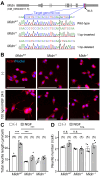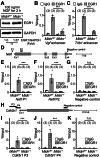Midnolin, a Genetic Risk Factor for Parkinson's Disease, Promotes Neurite Outgrowth Accompanied by Early Growth Response 1 Activation in PC12 Cells
- PMID: 39264361
- PMCID: PMC11529416
- DOI: 10.1080/10985549.2024.2399358
Midnolin, a Genetic Risk Factor for Parkinson's Disease, Promotes Neurite Outgrowth Accompanied by Early Growth Response 1 Activation in PC12 Cells
Abstract
Parkinson's disease (PD) is an age-related progressive neurodegenerative disease. Previously, we identified midnolin (MIDN) as a genetic risk factor for PD. Although MIDN copy number loss increases the risk of PD, the molecular function of MIDN remains unclear. To investigate the role of MIDN in PD, we established monoclonal Midn knockout (KO) PC12 cell models. Midn KO inhibited neurite outgrowth and neurofilament light chain (Nefl) gene expression. Although MIDN is mainly localized in the nucleus, it does not encode DNA-binding domains. We therefore hypothesized that MIDN might bind to certain transcription factors and regulate gene expression. Of the candidate transcription factors, we focused on early growth response 1 (EGR1) because it is required for neurite outgrowth and its target genes are downregulated by Midn KO. An interaction between MIDN and EGR1 was confirmed by immunoprecipitation. Surprisingly, although EGR1 protein levels were significantly increased in Midn KO cells, the binding of EGR1 to the Nefl promoter and resulting transcriptional activity were downregulated as measured by luciferase assay and chromatin immunoprecipitation quantitative real-time polymerase chain reaction. Overall, we identified the MIDN-dependent regulation of EGR1 function. This mechanism may be an underlying reason for the neurite outgrowth defects of Midn KO PC12 cells.
Keywords: PC12 cells; Parkinson’s disease (PD); early growth response 1 (EGR1); neurite outgrowth; neurofilament light chain (NEFL).
Conflict of interest statement
Yoshishiro Koyama is an employee of ThermoFisher Scientific KK (Tokyo, Japan) and contributed to the measurement of neurite outgrowth. Apart from this, the authors report that there are no competing interests to declare.
Figures






Similar articles
-
Midnolin is a novel regulator of parkin expression and is associated with Parkinson's Disease.Sci Rep. 2017 Jul 19;7(1):5885. doi: 10.1038/s41598-017-05456-0. Sci Rep. 2017. PMID: 28724963 Free PMC article.
-
Insulin Enhances Gene Expression of Midnolin, a Novel Genetic Risk Factor for Parkinson's Disease, via Extracellular Signal-Regulated Kinase, Phosphoinositide 3-Kinase and Multiple Transcription Factors in SH-SY5Y Cells.J Pharmacol Exp Ther. 2022 May;381(2):68-78. doi: 10.1124/jpet.121.001076. Epub 2022 Mar 3. J Pharmacol Exp Ther. 2022. PMID: 35241633
-
Midnolin gene expression is enhanced by Gq-coupled muscarinic acetylcholine receptor stimulation in SH-SY5Y human neuroblastoma cells.J Pharmacol Sci. 2025 Apr;157(4):229-232. doi: 10.1016/j.jphs.2025.02.006. Epub 2025 Feb 23. J Pharmacol Sci. 2025. PMID: 40058942
-
Transcriptome Analysis Reveals That Midnolin Regulates mRNA Expression Levels of Multiple Parkinson's Disease Causative Genes.Biol Pharm Bull. 2018;41(1):20-23. doi: 10.1248/bpb.b17-00663. Biol Pharm Bull. 2018. PMID: 29311479
-
Midnolin is a confirmed genetic risk factor for Parkinson's disease.Ann Clin Transl Neurol. 2019 Nov;6(11):2205-2211. doi: 10.1002/acn3.50914. Epub 2019 Oct 6. Ann Clin Transl Neurol. 2019. PMID: 31588691 Free PMC article.
Cited by
-
Mechanisms of ubiquitin-independent proteasomal degradation and their roles in age-related neurodegenerative disease.Front Cell Dev Biol. 2025 Feb 7;12:1531797. doi: 10.3389/fcell.2024.1531797. eCollection 2024. Front Cell Dev Biol. 2025. PMID: 39990094 Free PMC article. Review.
-
Comprehensive Analysis Reveals Midnolin as a Potential Prognostic, Therapeutic, and Immunological Cancer Biomarker.Biomedicines. 2025 Jan 23;13(2):276. doi: 10.3390/biomedicines13020276. Biomedicines. 2025. PMID: 40002690 Free PMC article.
References
Publication types
MeSH terms
Substances
LinkOut - more resources
Full Text Sources
Medical
Research Materials
